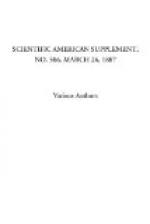Shells so gently put in motion, and having no windage, might be made, it might naturally be supposed, singularly thin, and the adoption of steel in place of iron calls for some explanation. The reason is that it has been found that common shells break up against masonry, instead of penetrating it, when fired from these large high velocity guns.
The shrapnel shell is shown at Fig. 5. Like the common shell, it is made of steel, and is of the general form of the pattern of General Boxer, with wooden head, central tube, and bursting charge in the base. It contains 2,300 four ounce sand shots and an 8 lb. bursting charge. It weighs 1,800 lb. The fuse is time and percussion. It is shown in Figs. 6 and 6A. It closely resembles the original Armstrong time and percussion pattern.
[Illustration: Fig. 6A.]
The action is as follows: The ignition pellet, A, which is ordinarily held by a safety pin, is, after the withdrawal of the latter, only held by a fine, suspending wire, which is sheared by the inertia of the pellet on discharge, a needle lighting a percussion patch of composition and the composition ring, B B, which burns round at a given rate until it reaches the communication passage, C, when it flashes through the percussion pellet, E, and ignites the magazine, D, and so ignites the primer shown in Fig. 6, flashes down the central tube of the shell, and explodes the bursting charge in the base, Fig. 5. The length of time during which the fuse burns depends on how far the composition ring is turned round, and what length it consequently has to burn before it reaches the communication passage, C. If the fuse should be set too long, or from any other cause the shell strikes before the fuse fires the charge, the percussion action fires the shell on graze by the following arrangement: The heavy metal piece containing the magazine, D, constitutes a striker, which is held in place by a plain ball, G, near the axis of the fuse and by a safety pellet, H. On first movement in the gun, this latter by inertia shears a suspending wire and leaves the ball free to escape above it, which it does by centrifugal force, leaving the magazine striker, D, free to fire itself by momentum on the needle shown above it, on impact. There is a second safety arrangement, not shown in the figure, consisting of a cross pin, held by a weak spiral spring, which is compressed by centrifugal force during flight, leaving the magazine pellet free to act, as above described, on impact.
The armor-piercing projectile is shown in Fig. 7. It is to be made of forged steel, and supplied by Elswick. In appearance it very closely resembles those fired from the 100 ton gun at Spezia, but if it is made on the Firmini system, it will differ from it in the composition of its metal, inasmuch as it will contain a large proportion of chromium, probably from 1 to 2 per cent., whereas an analysis of Krupp’s shell gives none. In fact, as Krupp’s agent at Spezia predicted, the analysis is less instructive than we could wish.—The Engineer.




